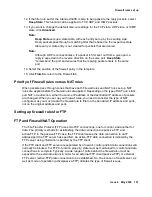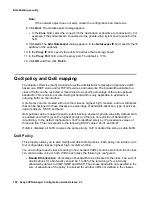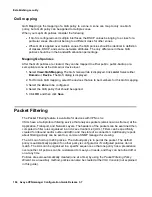
Voice Over IP
Issue 4 May 2005
175
WinNuke Attack. - This attack attempts to completely disable networking on computers that
are running Windows 95 or Windows NT. This attack can be swift and crippling because it uses
common Microsoft NetBIOS services. WinNuke attacks ports 135 to port 139 on platforms that
are based on Windows 95 and Windows NT.
Buffer Overflow. - This attack overflows the internal buffers of the application by sending more
traffic than the buffers can process. This attack can contain a program at the end of a packet
which can run and attack the system.
To select or deselect DOS categories
1. To set DOS rules, from the Configure Console window, select View>Firewall. Select the
DOS tab.
2. Select the rules that should be enabled and select to log details about attack attempts, if the
log function is available.
3. Click Save.
Voice Over IP
For servers running VPNos 4.2 or later, use the VoIP tab to enable or disable Voice over IP
(VoIP) and to configure the gatekeeper properties. Definition of the gatekeeper location is with
respect to the internal or external firewall definition. Beginning with VPNos Feature Pack 4.31,
use the VoIP property to configure the IP trunking properties. You can add, modify, or delete IP
trunking configurations.
Voice over IP uses the Internet Protocol to transmit voice as packets over an IP network. So
VoIP can be achieved on any data network that uses IP (Internet, Intranets, and Local Area
Networks). Here the voice signal is digitized, compressed and converted to IP packets and then
transmitted over the IP network. Signaling protocols are used to set up and tear down calls,
carry information required to locate users and negotiate capabilities. One of the main
motivations for Internet telephone is the low cost involved.
Using the IP Trunking Call Model
The IP Trunking call model should be used when there is an IP Trunk configured between
gatekeepers at separate locations and the call signaling messages (i.e. H.225 and Q.931
packets) between those gatekeepers is NATed by the device.
Summary of Contents for 3.7
Page 1: ...VPNmanager Configuration Guide Release 3 7 670 100 600 Issue 4 May 2005...
Page 4: ......
Page 20: ...Preface 20 Avaya VPNmanager Configuration Guide Release 3 7...
Page 32: ...Overview of implementation 32 Avaya VPNmanager Configuration Guide Release 3 7...
Page 53: ...Preferences Issue 4 May 2005 53 Figure 16 Tunnel End Point Policy...
Page 54: ...Using VPNmanager 54 Avaya VPNmanager Configuration Guide Release 3 7...
Page 244: ...Using advanced features 244 Avaya VPNmanager Configuration Guide Release 3 7...
Page 292: ...Upgrading firmware and licenses 292 Avaya VPNmanager Configuration Guide Release 3 7...
















































